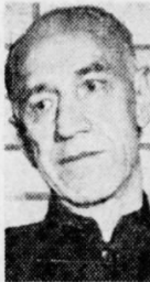 The Minneapolis Star, August 19, 1955 Leonard Hankins was sentenced to life in prison in 1933 for the murder of a policeman during a bank robbery in Minneapolis, Minnesota. Hankins was declared innocent by the Minnesota Pardon Board in March 1953, based on admissions by two of the robbers that Hankins was not involved in the crime and several witnesses who admitted that their identification of Hankins could have been erroneous. On December 16, 1932, armed robbers held up the Third Northwestern National Bank of Minneapolis. In the course of the robbery, two Minneapolis policemen, Ira Evans and Leo Gorski, were shot and killed as they responded to a call for help. A St. Paul man was also shot and killed after witnessing the robbers changing cars at Como Park in St. Paul. On December 18, 1932, Minneapolis police arrested Leonard Hankins when he walked into a rooming house. Hankins, a gambler from Kentucky, had a gun in his possession at the time of his arrest that matched the caliber of one of the guns used in the bank robbery. Hankins was tried in Minneapolis on January 25, 1933. Despite the fact that Hankins denied any participation in the bank robbery, several witnesses identified him as one of the robbers. In addition, it was brought out at trial that Hankins’ gun was similar to one of the guns used during the robbery, although none of the bullets from the robbery were ever matched with the ballistics of Hankins’s gun. One witness testified that Hankins was not one of the bank robbers, and a barber corroborated Hankins’s story that he was getting a haircut in St. Paul at the time of the robbery. Nevertheless, Hankins was found guilty of first-degree murder on February 6, 1933 and sentenced to life imprisonment. Hankins began serving his life sentence in 1933 at the Minnesota State Prison at Stillwater, Minnesota. In 1935, the FBI captured Jess Doyle, who told the authorities that the 1932 bank robbery had been carried out by the Barker-Karpis gang. In his confession, Doyle named the men who had participated in the robbery and said that Hankins was not one of the robbers. Several other members of the gang were caught later, and they also said that Hankins was not involved in the robbery. Another one of the bank robbers, Lawrence DeVol, was arrested at an apartment in St. Paul. DeVol pled guilty to a charge of first-degree murder in connection with the robbery. He was sentenced to life in prison. On January 9, 1936, M.C. Passolt, the Superintendent of the Minnesota Bureau of Criminal Apprehension, interviewed Doyle about the bank robbery. Doyle confirmed to Passolt that Hankins was not involved in the robbery. Then, on February 6, 1936, Passolt interviewed DeVol, who corroborated Doyle’s story and stated that Hankins was not involved in the robbery. In 1936, a reporter from the Associated Press, Jack MacKay, also interviewed DeVol, who told him that Hankins had nothing to do with the bank robbery. MacKay contacted several witnesses who had identified Hankins as one of the robbers. All but one of the witnesses admitted that they could have made a mistake in identifying Hankins. MacKay took the information that he had uncovered to the state attorney general, who obtained a portion of the Doyle confession from the U.S. District attorney in St. Paul. However, nothing was done with the information uncovered by MacKay for several years. Throughout Hankins’s imprisonment, Hankins’s sister, Della Lowery, and his attorney, John Kelly, worked to prove his innocence. In addition, a former Minneapolis police detective uncovered some of the evidence that ultimately freed Hankins. Lowery and Kelly contacted the members of the Pardon Board in Minnesota many times during Hankins’ incarceration at the Stillwater prison. The Pardon Board consisted of the governor, the attorney general and the chief justice. Although the Pardon Board became interested in the Hankins case on several occasions, many years passed before it finally recognized that Hankins had been wrongfully convicted. The Board heard his case twelve times before witnesses were found who established his alibi. The county attorney who had originally prosecuted Hankins consistently objected to Hankins’ release. In November 1951, Hankins was granted a conditional commutation of his sentence by the Minnesota Pardon Board, and, on February 25, l953, he was given his final unconditional release. In March 1953, the Minnesota Pardon Board declared Hankins innocent, stating that he had been cleared of guilt. In 1955, the Minnesota state legislature passed a bill to pay Hankins an annuity of $300 per month for the rest of his life and to pay Lowery $10,000 to reimburse her for her expenses in fighting for her brother’s release. The bill also provided $5,000 for Kelly, the Minneapolis attorney who was appointed by a district court judge to defend Hankins in 1933. Together with writer Earl Guy, Hankins published a book documenting his experiences entitled “Nineteen Years Not Guilty” in 1956. - Researched by Anne M. Pachciarek and Christopher J. Beal
|